Cep – Identification, distribution, edibility, ecology, sustainable harvesting
Boletus edulis (also the closely related and equally delicious Boletus pinophilus and Boletus reticulatus); AKA Porcini (Italy & commonly UK too nowadays), Penny bun (UK traditionally, but generally cep from the French name Cepe is used), Steinpiltz (Germany), King bolete (US) (N America has more very similar boletus species (eg. B.rex-veris) that are often lumped in with Boletus edulis as they are very similar and equally gastronomic. These are not covered in this post).
- Edibility – 5/5 – firm young ceps are one of the tastiest wild foods, and extremely versatile. Older specimens are best dried, after which their flavour intensifies. Their only downside is that pretty much everything finds them delicious, so finding decent ceps is a race against slugs, bugs and other fungi.
- Distribution – 3/5 – quite common, though enigmatic, often with a short, intense season (3 weeks around the start of September in Scotland, usually later further south), and rapidly infested/decomposing.
- Identification – 4/5 – Key identification features are the light to chestnut brown smooth cap with a white rim and often a hazy pale ‘bloom’. Ensure the stipe is pale with a slightly raised white net pattern (reticulum) on the top third. As a member of the bolete group of mushrooms, ceps have pores under the cap rather than gills. These start off pale grey, becoming yellow and eventually olive green in past-their-best specimens. Flesh should be unchangingly white throughout apart from a narrow claret-coloured line just under the skin of the cap. Beginners may mistake inferior boletes, but unlikely to be a dangerous mistake. Ceps grow quickly and come in a wide and quirky range of shapes and sizes, and are often semi-decomposed before they reach maturity.
- Habitat – under beech, birch, scots pine, spruce; solitary or in clusters. Summer cep (Boletus reticulatus) grows only under deciduous trees, tends to appear earlier in the year, and is distinguished by its pronounced reticulum and darker cap. Boletus pinophilus (aka the pine bolete or pine cep) grows only under pine or spruce (including plantations). Both are every bit as tasty as boletus eludis and there is no need for fungi novices to worry too much about the subtle differences.
- Ecology – Ceps are Mycorrhizal fungi, working with their tree partners by helping in their uptake of water, phosphorus, nitrogen and zinc in return for energy from photosynthesis in the form of sugars. Carbon sequestration by fungi has historically been a somewhat overlooked area of climate science. Ceps, and boletus species in general, can be important food and habitat to insects, slugs, rodents and I’ve even heard of deer nibbling on them. This fascinating paper shows that individual mushroom species can have specific relationships with individual insect species. In the case of ceps, (mostly) flies of the pegomya genus, and (some) fungal gnats of Sciaridae family use them as food home & nursery for their larvae. It has been postulated that insects could play a role in the reproductive strategies of some fungi (beyond the obvious stinkhorns) and who knows what other useful interactions they have with complex fungal lifecycles? The evolution of veils/rings (annulus), webs (cortina) and slime on the underside of some mushroom species is a direct defence to deter insects before spores have matured. Some slow growing fungi such as chanterelles deter insects chemically (read the science of this here). That ceps have evolved no such strategy suggests to me that they they are happy partners with insects as well as trees! It seems likely that their very aromatic deliciousness has evolved to attract insects… And maybe humans too? Ceps can also play host to other fungi, notably the bolete eater fungus Hypomyces chrysospermus, and appear to have complex relationships with Fly agaric (amanita mascaria), the miller (Clitopilus prunulus) and peppery boletes (Chalciporus piperatus) – more on which below.
- Considered/Sustainable Harvesting – Given their extremely very fast growth/deterioration, the rapid attentions of so many insects, slugs and rodents, and their susceptibility to bolete eater fungus, its not surprising that millions of tons of ceps mature and rot in our forests every autumn. They are a true feast for nature. Their tendency to appear in large, localised gluts (like mast years for trees, only more localised and much less predictable) means harvesting a large “windfall” in one go can be a perfectly reasonable harvesting strategy. One good afternoon can yield a year’s supply of fungi, once dried or otherwise preserved and this must certainly have a lower overall impact than buying hothoused, packaged, transported cultivated mushrooms. Read more on this here. Carrying ceps pores-down in an open weave basket can only help in the wider transmission of spores through forest habitats, and spreading around the inevitable trimmings and wastage for such a perishable mushroom.
Suggested reading: An Introduction to Fungi Foraging
The cep is the king of edible mushrooms. No food, fungal or otherwise, comes near it for flavour and texture and when you find a firm young penny bun, or ‘bouchon’ cep as the French call them (after champagne corks), there is an irresistable fairytale beauty to them which is both beautiful and seductive.
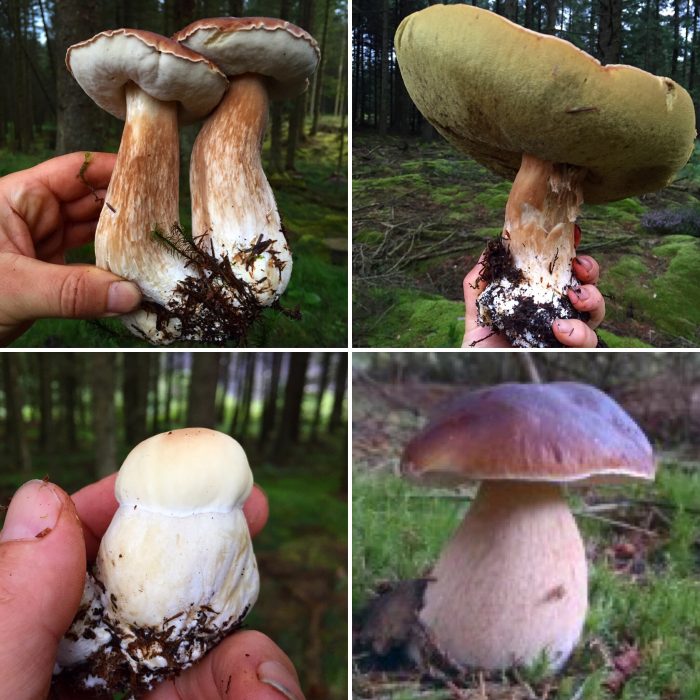
Boletus edulis grow rapidlyy and erratically. All these ceps were picked in the same area at the same time. Bottom left is a freshly emerged “bouchon” (champagne cork) that is yet to colour up. Note the pores on the underside of the cap, changing from pale to olivaceous yellow as the mushroom matures.
In prime condition, ceps are one of the few wild mushrooms that I recommend eating raw, though if you have never tried them before, you should start with only a tiny amount. Fortunately a morsel is all you need to intoxicate your senses. The texture manages to be both crisp and succulent, while the flavour is one of chestnuts, musky woodland, even a hint of smokiness, but overall, just very mushroomy, with an almost parmesan-like umami mouth feel! The combination of deep intensity and aromatic lightness is fantastic.
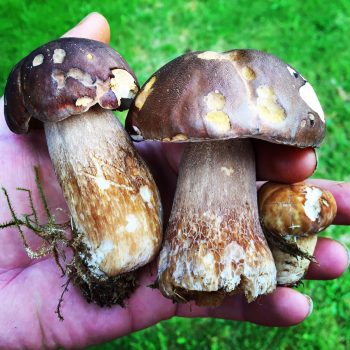
Summer ceps, Boletus reticulatus. Differentiated by the deeper chestnut colour of the cap and darker stem with prominent white reticulum. Image ©GallowayWildFoods.com
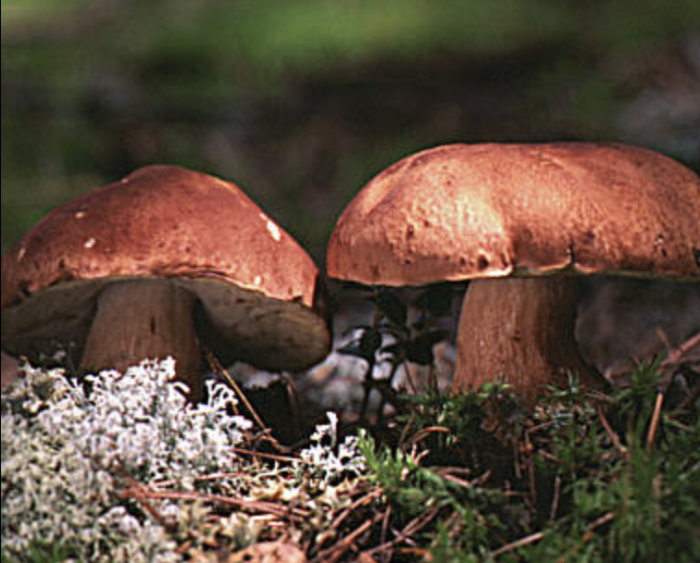
Boletus pinophilus – Pine ceps, have a ruddier complexion and are found only under conifers, especially pine, but also spruce and fir. They are just as delicious as, though less common than, b.edulis, which can also be found in similar habitats. More common in Scotland, scarce in England. Image: WikiCommons
If you think all this sounds unlikely and exaggerated, you really should try one. And don’t take my word: witness the French and (especially) Italian love affair with this mushroom. In season, market stalls will be bursting at the seams with fresh specimens and most rural Italian towns have their own fungi festival each autumn where prizes are awarded for biggest/prettiest/most like finder porcini. Even in winter and spring no self respecting grocer will be without a huge box of dried porcini.
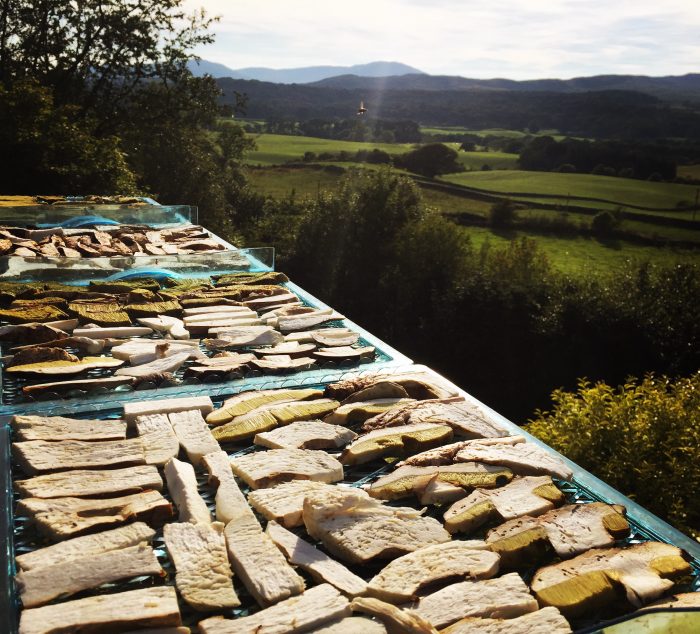
Dehydrating ceps in the sun. I usually use a dehydrator for speed and convenience, but on the rare occasion Scotland’s weather is good enough, I dry them in natural sunlight
Ceps lend themselves extremely well to drying and young firm specimens also freeze well, so they are available commercially in some form or other all year round and are a widely traded commodity. Although they lose their texture when dried, the process actually intensifies the flavour, and there is the added bonus of the water used for reconstituting them making excellent mushroom stock, though generally I prefer to just add the dried chunks to whatever stew, sauce, soup or gravy I am making and let them reconstitute in the pan. Dried ceps can also be ground into a fine stock powder that will turbo-charge any dish with rich, deep umami, or can be sprinkled on dishes in the same way as parmesan cheese.
Small firm specimens can be fermented or pickled, though unless you hit the jackpot, I think the bourbons are best kept for eating raw in salads.
You may well be thinking that this is some rare, exotic species, but they are in fact, not hard to find in Scotland and much of the UK. It is a sad reflection on our mycophobic culture that while they are cherished and celebrated in Europe, they are more likely to be ignored or kicked in the UK! Ceps are mycorrizal mushrooms, meaning that their parent mycelium (the underground network of microscopic fibres that permeate topsoil) happily unites in a mutually benificial relationships with tree roots. Ceps are what I think of as ‘loose’ mushrooms in so far as they can associate with a variety of tree species. Such infidelity means that you can regularly find them beneath beech, birch, pine and spruce trees from late August to November (see notes above for variations in species).
Tracking down such an esteemed mushroom can become a bit of an obsession, and experienced hunters will have all their senses finely attuned to a complex interplay of influences: heat in the ground (hot summers are good, but only after the weather breaks), rainfall (cloudburst in September), drops in temperature (a trigger for mushroom growth) and the appearance of other species that associate with ceps, are all signs to get your basket ready.
Fly agaric (amanita muscaria), the miller (Clitopilus prunulus) and peppery boletes (Chalciporus piperatus) are often clues to good hunting -grounds, especially under spruce trees. I find the relationship between ceps, spruce trees, the miller and the peppery bolete to be so reliable that I believe (though i’ve seen no scientific research to prove this) that the relationship is more than just shared habitat, but a complex interdependency. It has been known for some years that peppery boletes are parasitic on fly agaric mycelia, but I suspect there is more at play here. Who knows what complex battles, alliances and trades are going on beneath our feet!?
Fly agaric, peppery bolete and the miller – all good signs that there may ceps about under pine and spruce
I often curse the monoculture created by huge swathes of sitka spruce plantations, but as mushrooms don’t need light to flourish, I must confess to gathering some tremendous hauls of ceps beneath their boughs. In 1998 W Scotland enjoyed unbroken hot weather right up to September when heavy rain broke the drought, resulting in a fungi invasion. I harvested nearly 50kg of prime bouchon cep from a 500 square metre area of south-facing sitka spruce plantation – and I was only taking the best 10% of what was there. We ate a lot of risotto that winter…
Inexperienced foragers can have trouble distinguishing ceps from other less desirable pored mushrooms or boletes, often due to wishful thinking. This is not the worst of failings as only the red pored and rare devil’s bolete is dangerously poisonous, though several can be bitter and indigestible. It doesn’t help that ceps are very fast growing and their appearance changes rapidly during the few days it takes them to emerge, mature and begin to rot.
Which leads me to the bad news…
The one downside to gathering ceps, it is that insects value them every bit as much as we do. I try to be philosophical about this, remembering that they are food, home and nursery to a great many beasties with fine taste, and an important part of the woodland ecosystem. But when 90-95% of outwardly perfect specimens turn out to be infested (often even before they have fully emerged from the ground), it is hard not to become dispirited.
I usually expect a ratio of about 1 salvageable cep to 10 knackered ones. Fungal gnats (Sciaridae spp) in particular appreciate them even more than humans as food home & nursery for their larvae. We may curse them, but they do help to spread fungal spores, and who knows what other useful interactions they have with complex fungal lifecycles? In my experience, unless I get really lucky, less than 1 in 25 of the ceps I find contain no gnat larvae at all. This isn’t as bad as it sounds, as trimming, slicing and quickly/thoroughly drying means the larvae fall out, leaving perfectly delicious cep with the already superb flavour intensified. Anyone who feels squeamish about this should know that nearly all commercially sold dried porcini (including that which is used to flavour tinned mushroom soup!) will have been home to fungal gnat larvae at some point.
Fed up of infested, mushy ceps? Why not hunt slower growing, insect resistant mushrooms like hedgehog mushrooms, winter chanterelles or chanterelles instead? You can read more in depth about their ecology and durability here too.
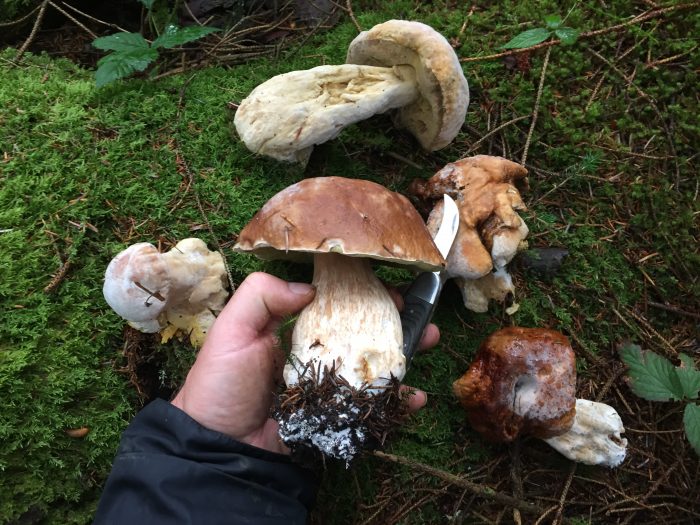
Four victims of the bolete-eater fungus and one good-looking cep for drying (as it still has plenty of fungal gnat larvae in it)
Everything loves to eat ceps, including other fungi! In action in this picture (above) is bolete-eater fungus, Hypomyces chrysospermus, which starts off as a white mould on the pore surface of boletes, then quickly spreads throughout the whole mushroom, turning chrome yellow as it matures and rendering its host a pile of smelly moosh in a matter of hours! I get sent a lot of ID requests for festering carcasses of hypomyces victims. Bleurgh.
For more advanced gourmet mycophagists only…I’ve discovered that if you can catch your ceps at the very early stages of Hypomyces chrysospermus infection – characterised by the odd rusty spot, perhaps the very beginnings of mould/mushiness and a somewhat cheesy smell – this actually adds wonderful parmesan-like umami to the mushrooms once dried. Really good, but i’m only talking about the very early stages of infection here.
Ceps, dried or fresh, will lift any mushroom dish to a new level. Even a small amount added to other mushrooms can make quite a difference. Here are some of my favourite recipes – but be sure to try them raw in the forest first!
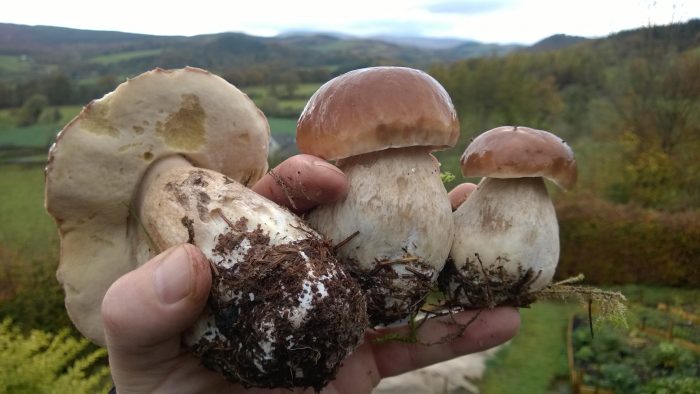
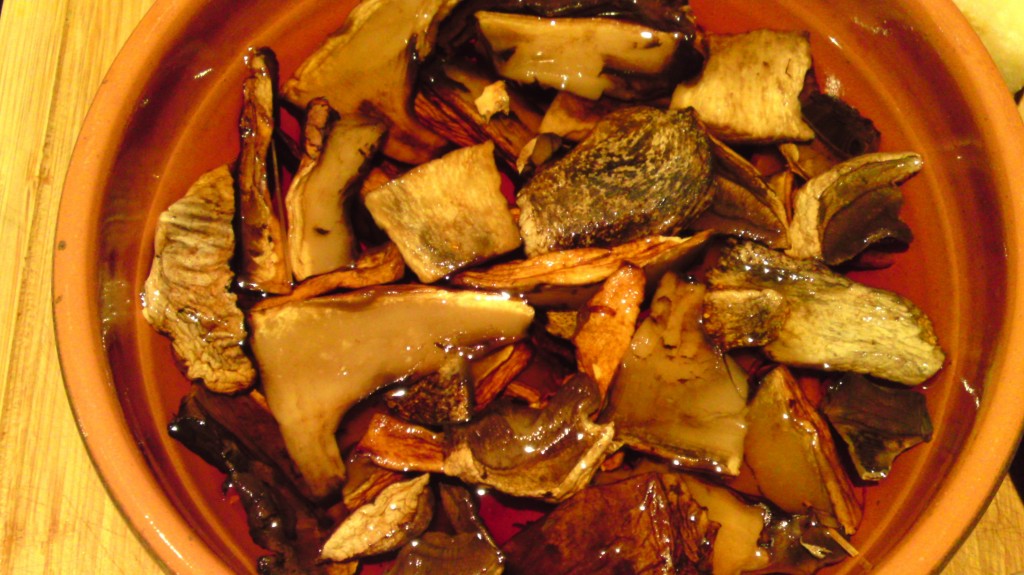
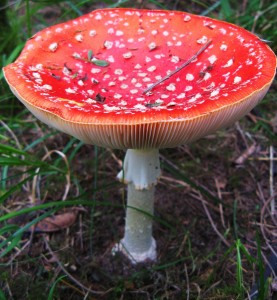
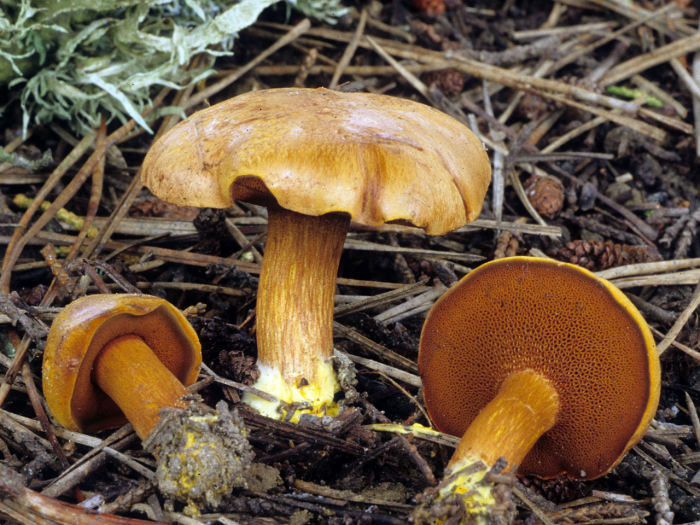
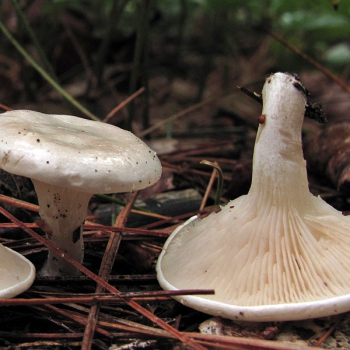
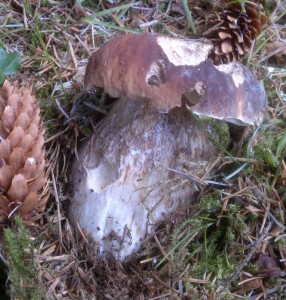
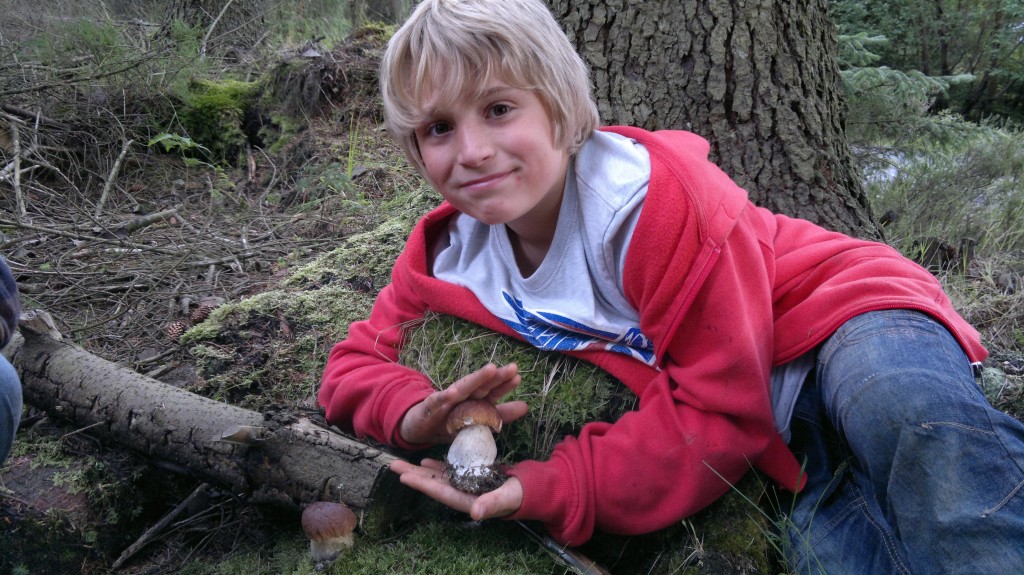
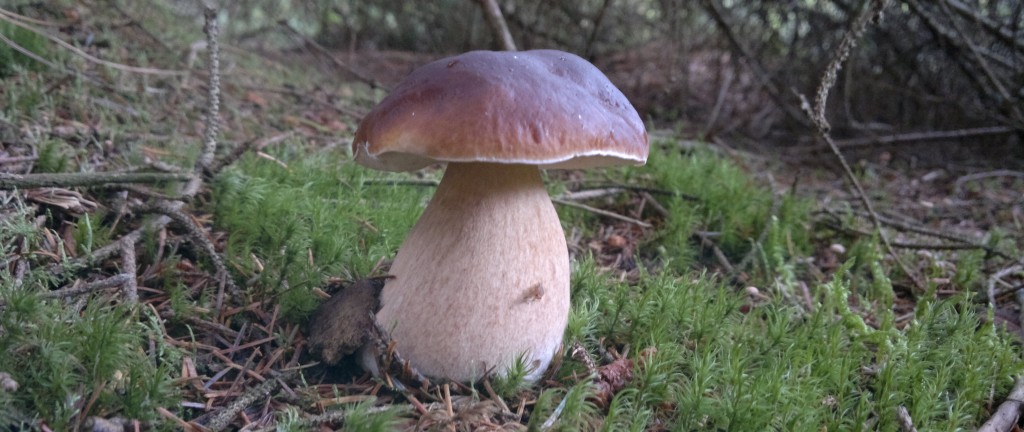
30 Comments
In a lot of your photos you show completely uprooted mushrooms. I heard it was best for mother nature to use a knife and cut 1 cm above the ground so they can grow back again. This also allows others to enjoy mushroom hunting as much as you do:) Thanks for the article, it was insightful! Happy hunting!
I wrote at length about the cutting v uprooting debate here:
In short, its more complicated than you think! (And no, cut mushrooms don’t grow back from the cut stipe!)
https://gallowaywildfoods.com/how-to-harvest-wild-mushrooms-cutting-v-picking-26711/
What, no mention of horse whisperer author Nicholas Evans mistaking Deadly Webcap for Ceps in 2008 and poisoning himself, his wife and two others?
No. That was such a bizarre, freakish and unfortunate mix-up that I think its not helpful to scare people with such a sad, much-recycled, but ultimately unhelpful story. Ceps are not at all like deadly webcaps. And other reports say he mistook them for chanterelles – an equally unfathomable mix-up.
It’s true that that misidentification is a rather surprising mistake, but I think the fact it did happen, and the consequences – if it is true one of the party only ate a few mouthfuls and nevertheless required a kidney transplant within a few years – is quite enough to explain why many of us who quite happily eat wild fruit are extremely scared of eating wild mushrooms!
I once picked an ivy berry in mistake for an elderberry. In my defence, both plants were growing through the same hedge in the same place. I spat it out, and, as far as I know, have suffered no ill effects (though I suppose if I end up with liver failure at the age of 60, it’s unlikely to be possible to link cause and effect).
I’d be interested to know if those who are more widely into foraging consider that a more or less surprising mistake than confusing a cep with a deadly webcap? Ivy and elder look nothing like each other.
I did a similar thing, with far less excuse, with a rose hip and another red berry on one occasion – I never worked out what I’d bitten into on that occasion.
Mushrooms are harder to identify than plants: there is less to go. And making a similar mistake of the sort that I made with fruit on those occasions with the wrong deadly mushroom, could lead to at least significant morbidity.
If I make a mistake with fruit or nuts in the UK (this may not hold in some parts of the world), the worst thing that’s likely to happen is that I’ll throw up. That could happen with any purchased food too. It’s not worth worrying about, beyond trying to remember to pay attention! But if I make a mistake with a mushroom, I’m liable to die. I understand people commenting that mushrooms aren’t any worse than UWU (unidentifiable white umbellifers), but I personally wouldn’t attempt foraging for those either if I wasn’t starving.
I’d love to get beyond blackberries, rosehips, and hazelnuts – the things I was brought up picking – but I don’t want to get into any of the risky areas. I am incorrigibly absent-minded (dyslexia) and sometimes taking responsibility means accepting that you don’t have the required capacity for some tasks.
Have you any advice on areas that are reliably safe, for the same sort of value of “safe”?
You can’t go wrong with seaweeds in UK waters – none that you pick from clean water, on foot are toxic (there are 2 subtotal species that might give you a blister on your tongue though!). The mint, allium and brassica family are among the safer plant families to focus on. Sticking to the bolete and bracket fungi groups minimises the possibility of encountering something poisonous, though identification still requires care and attention.
Thanks 🙂 it’s appreciated.
That story was totally unbelievable. Horsey country types mistaking the world’s most famous culinary mushroom, a boletus, for one with gills which doesn’t look remotely similar.
Fear porn story for me, a fabrication.
This article in the BMJ may change your mind: https://www.bmj.com/content/345/bmj.e5262
This BMA article is well worth reading for its inside story of what can go catastrophically wrong if you mis-identify a mushroom. We can all tut-tut about someone else’s decision in hindsight but we need to be constantly vigilant about being sure of what we put in the pan. I had a dodgy 48 hours after a few bits of Yellow Stainer got into my Field-Mushrooms on toast last year. Salutory experience. Last week I brought home a couple of Death Caps found locally to examine all their features for my future reference. My wife became quite alarmed at what I had found…’Take that loaded gun out of the house!! You might leave it on your desk and one of the dogs might eat it!’ We need to balance sound identification against the huge fun of finding great specimens of the edibles. I have found some great Ceps in the last 2 weeks with the rainy weather. Take NO RISKS though. Good truffling to you all. John
I lived on the Altyre estate the time this happened, it was tragic and not a good outcome for either of men involved. Thank god the children didn’t have any of the food produced with the mushrooms, I dare say it could have been fatal. It was definitely not a fabrication.
Not at all. Read this article, he says he often picks chanterelles, but ceps only once with a friend 12 years before the incident and in another part of the country. It is a huge mistake, no doubt, but he claims he picked them young, if you look at young specimen pics, some of them have a fully rounded top, the gills not showing yet and a similar coloration, so yes, to the (very) untrained eye they might look similar, also, and most importantly in my opinion, he was told by someone that there were some chanterelles and ceps in the woods, so he went there already expecting to find that, as if they were already identified.
Full article here: https://www.thenakedscientists.com/articles/interviews/nicholas-evans-poisonous-mistake
If it turns blue its psilocybin bearing meaning its the trippy kind
This is not true.
There are a lot of these coming up now near me in South northants.
The stalks turn streaky blue/violet after a while. Are they OK to eat.
Doesn’t sound like cep if its discolouring. If you are sure it is a bolete, try looking at this post https://gallowaywildfoods.com/scarletina-bolete-edibility-distribution-identification/
I wonder if what you’re seeing are Leccinums https://en.wikipedia.org/wiki/Leccinum
Flesh goes dark/blue after cutting.
Hi, some of the ceps we picked are colouring mildly yellow below the skin of the cap when cutting. Should this concern us?
No, not if you are sure you have ceps. But be aware of bolete-eater fungus (discussed in this post), which discolours rusty brown initially, and gives a cheesy smell. A tiny bit of that actually adds to the flavour IF you are drying it, but should otherwise be avoided.
Very helpful article. Love love love ceps and have been foraging for some today, but to no avail.
Will head out in the morning dew tomorrow for another hunt.
Thanks
Very helpful thank you.
Im in the south of France and found some last year but i have to admit they’re really difficult around here which is mainly agrigcultural land . We do have pine trees but i’m not sure of the species in these small left over forests.
Its October now , have i missed the boat?
I don’t know how autumn plays out in S of France, but the fungi season generally moves N to S, so for eg. early September is high season on Scotland, where as October is high season in S England, So I guess you’ll be later still.
We are also in S of France and ceps still around now ( first of November) ; The main problem here is not flies , or slugs but rather the fact that the locals are more committed and knowledgeable ! They also go out hunting about 3 hours before us …
I have just found a group of five Ceps or what I believe are Ceps here in Devon on the 19th July 2021 ? They look the right shape with the correct colours, bronze caps, pale pores in the smaller younger fruits and olive green in the older larger fruits. They are on the edge of a track in mixed native hardwood and pine woodland.
If I found these in October I wouldn’t have any doubts whatsoever but at this time of year I’m puzzled.
Should I be puzzled?
Ceps can occasionally be “tricked” into early ‘fruitings’ by, say, an unexpected drop in temperature, heavy rainstorm etc. There is also the summer cep, b.reticulatus (discussed in the post above), which tend to emerge earlier.
I’m pretty sure this is a cep. Do you agree? I found this under small deciduous trees in Northumberland. Last year I found loads under or on the edge of spruce woods but I’ve moved so this is much closer.
Hard to say without a photo!
Found a couple of ceps growing on a rotting trunk They look very Chestnut bolete but I have never seen them on well-rotting wood (beech) before. White pores, short stem not overly hollow and no dicolouration with a chestnut cap No more than 8-10 cm the other had been enjoyed by something else! Taste very nice raw. Many thanks
Ceps are mycorrhizal fungi, meaning the mycelium grows in conjunction with tree roots. Fungi that grow on dead/decaying logs are saprophytic. This means the fungi you found wasn’t a Cep.